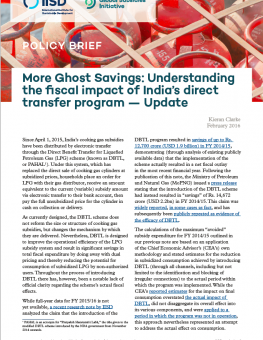
More Ghost Savings: Understanding the fiscal impact of India’s direct transfer program - Update
The Government of India claims to have saved over 2 billion dollars in the first year of the operation of its direct benefits transfer scheme for LPG (DBTL). This policy brief tests this claim.
The Government of India claims to have saved over 2 billion dollars in the first year of the operation of its direct benefits transfer scheme for LPG (DBTL). This policy brief tests this claim.
In early 2015, the Government of India implemented reforms to the system of domestic LPG subsidies, replacing integrated consumer price subsidies with a system of electronic transfers through the Direct Benefit Transfer for Liquefied Petroleum Gas (LPG) scheme.
The Government of India has claimed that, by improving the operational efficiency of the LPG subsidy system, DBTL resulted in significant savings in total fiscal expenditure on LPG subsidies in fiscal year 2014-15. While initiatives which predated the introduction of DBTL have been successful in identifying and blocking irregular connections, IISD’s analysis of publicly available data suggests that DBTL itself had little impact on total fiscal expenditure in fiscal year 2014-15.
You might also be interested in
India Faces Clean Energy Challenges as Energy Demand Soars and Global Fossil Fuel Subsidies Rise
New research finds the global energy crisis and increasing energy demand have pushed India's energy subsidies to a 9-year high.
G20 energy ministers call for cooperation on nuclear energy & low-emission hydrogen
The Group of 20 energy ministers' meeting concluded in Goa on July 22, 2023, with the final summary failing to include language on the phase-down of unabated fossil fuels.
Implementing Solar Irrigation Sustainably
This guidebook provides recommendations to state policy-makers on how they can implement solar irrigation models, particularly decentralized solar plants for irrigation under the PM-KUSUM scheme, effectively and sustainably.
G20 Finance Ministerials and World Bank/IMF Spring Meetings: Expert comment
G20 finance ministerials and World Bank/IMF spring meetings will take place this week in Washington. High on the agenda is the need to mobilize trillions of dollars of investment in the transition to clean energy.